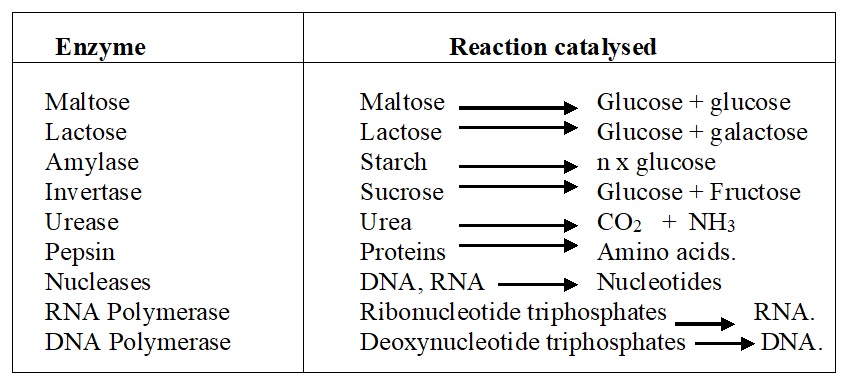The enzymes the biological catalyst produced by living cells which catalyze the biochemical reactions in the living organisms. Chemically all enzymes are globular proteins. Without enzymes, the living processes would be very slow to sustain life. For example, without the presence of enzymes in our digestive tract, it would have been very difficult to digest a single meal. There are about 3000 enzymes have been identified. The enzymes are highly selective and specific in nature.
Some common enzymes and their reactions which are catalyzed by them are given below:

Properties of Enzymes: The important characteristics of enzymes are —
- They can speed up an uncatalysed reaction to the extent of a ten million times.
- They are active at moderate temperature (310K) and pH (6-8).
- They are highly specific in their action.
- Their action can be controlled or even inhibited by certain organic or inorganic substances.
- Even a small amount of enzymes can be highly efficient.
Coenzymes: Certain enzymes require non-proteinous components for their activity. These components could be metal ions like Zn2+, Mg2+, Cu2+, Co2+, K+, Na+ etc. or small organic molecules are collectively called co-enzymes. Many of the coenzymes for biological processes are derived from vitamins like thiamine, niacin, riboflavin, etc. In such enzymes the protein part of the enzyme is called the apoenzyme.
Applications of Enzymes:
1) The deficiency of phenylalanine hydroxylase enzyme causes a congenital disease called phenylketone urea. This disease causes accumulation of compounds in the body which results into severe brain damage and retardation in children. This can be prevented by a diet with low phenylalanine content.
2) Deficiency of enzyme tyrosinase causes albinism.
3) Certain enzymes are also used for treating heart diseases.
4) Enzymes are used in industry viz in food processing, in the manufacture of beer, wine and in the production of cheese by coagulation of milk.